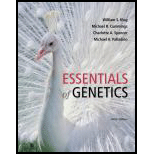
Concept explainers
Describe Mendel's conclusions about how traits are passed from generation to generation.
To review:
Mendel’s conclusion about the mechanism by which traits are passed from generation-to-generation.
Introduction:
Gregor Mendel was an Austrian monk who proved that traits are passed through a certain unit of heredity from one generation to another. He conducted experiments using pea plants with different variants. Before Mendel, people had a concept that the traits were inherited by the next generation due to the blending of parental characters just like colors.
Explanation of Solution
Mendel conducted experiments using pea plants with variants such as variation in flower color, pod color and shape, seed color, and many other characters. That was a long series of experiments. Mendel got various results, which indicated that traits are transferred from one generation to another in a specific way that can be predicted.
He concluded that there are certain factors responsible for passing traits to offspring from the parents. These factors control the traits. This means each trait is controlled by a pair of a factor. These factors were later known as genes. At the time of gamete formation, the gene pair gets separated from each other. For a single trait, the offspring get one gene from each parent and have the pairing of two genes. Thus, the traits are transferred through genes.
Therefore, it can be concluded that according to Mendel, traits from the parents to offspring are transmitted through predictable factors known as genes.
Want to see more full solutions like this?
Chapter 1 Solutions
Essentials of Genetics (9th Edition) - Standalone book
- Which of the following statements is false regarding thymine dimer mutations? A). they form between two adjacent thymine bases in the DNA. B). they are usually fixed by DNA polymerase repair enzymes. C). they are caused by UV radiation. D). they can form between a purine and a pyrimidine in the DNA.arrow_forwarddiscuss one issue with regard to medical care. This can include (but not limited to); rising costs of medical care, problems with access to care, conflicts between public health and the medical profession, etcarrow_forwardA. Describe the steps in a PCR reaction in detail B. Describe what it means that DNA replication is semiconservative. C. Discuss chromatin remodeling D. Draw a prokaryotic replication fork and include all of the major proteins associated with prokaryotic DNA replication and also label leading and lagging strands, Okazaki fragments, 3' and 5' ends of both sides of the fork, primers, and anything else relevant to replication.arrow_forward
- What is a transposon, and what are two different types of transposons?arrow_forwardTranscription in eukaryotes: A). can happen on either strand in the 3'->5' direction B). uses the enzyme DNA polymerase C). results in a double-stranded end product D). produces only one type of RNA molecules E). all of the abovearrow_forwardThe majority of our non-coding DNA consists of A. Pseudogenes B. Introns C. Regulatory Sequences D. Transposons E. Proteomesarrow_forward
- a) Describe how genotype data for an array of SNPs can be used in a GWAS. b) How is artificial selection of dogs responsible for the array of different dog phenotypes that we see today? Refer to the pre-lab article called: “Variants in Three Genes Account for Most Dog Coat Differences.”arrow_forwarda) What “soft” skills does a genetic counselor need that might not be quantified by achieving a degree in a STEM field. Soft skills are interpersonal skills like active listening, time-management, and problem solving. b) Why are pedigrees a tool used in genetic counseling and what might they tell the person or people being counseled? c) Identify two to three tricky ethical situations a genetic counselor may run into when working with a couple who are expecting a baby.arrow_forward11:23 PM Fri Dec 6 Question 2 Not yet answered Points out of 1.50 Flag question ... moodle.lsu.edu In quail, the gene for blue eggs is autosomal recessive (represented by "c"), so is the gene for an albino phenotype (represented by "a"). You cross two known heterozygotes of the aforementioned genes and observe the offspring produced. Your gut tells you that something is off with the results. Conduct a chi-square test to determine if the observed offspring match what was expected. Genotype Brown Feathers; Speckled Eggs Brown Feathers; Blue Eggs Blue Eggs; Albino Speckled Eggs; Albino Total Observed 25 5 10 5 45 Answer the following question to a single number past the decimal point without rounding, such as 1.1. The only thing you should type into this box is a number. What is the chi-square value? 26%arrow_forward
- Hello, Can you please help me to develope the "Toxic shock syndrome" please? (I would apreciate no AI) overview of the disease A description of the causative agent A description of the mode of transmission A description of the treatment for the disease A brief overview of any preventative methods for transmission. Thank you in advance!arrow_forwardNot use ai pleasearrow_forwardDon't give AI answer otherwise I will give you downward Give typing answerarrow_forward
 Human Anatomy & Physiology (11th Edition)BiologyISBN:9780134580999Author:Elaine N. Marieb, Katja N. HoehnPublisher:PEARSON
Human Anatomy & Physiology (11th Edition)BiologyISBN:9780134580999Author:Elaine N. Marieb, Katja N. HoehnPublisher:PEARSON Biology 2eBiologyISBN:9781947172517Author:Matthew Douglas, Jung Choi, Mary Ann ClarkPublisher:OpenStax
Biology 2eBiologyISBN:9781947172517Author:Matthew Douglas, Jung Choi, Mary Ann ClarkPublisher:OpenStax Anatomy & PhysiologyBiologyISBN:9781259398629Author:McKinley, Michael P., O'loughlin, Valerie Dean, Bidle, Theresa StouterPublisher:Mcgraw Hill Education,
Anatomy & PhysiologyBiologyISBN:9781259398629Author:McKinley, Michael P., O'loughlin, Valerie Dean, Bidle, Theresa StouterPublisher:Mcgraw Hill Education, Molecular Biology of the Cell (Sixth Edition)BiologyISBN:9780815344322Author:Bruce Alberts, Alexander D. Johnson, Julian Lewis, David Morgan, Martin Raff, Keith Roberts, Peter WalterPublisher:W. W. Norton & Company
Molecular Biology of the Cell (Sixth Edition)BiologyISBN:9780815344322Author:Bruce Alberts, Alexander D. Johnson, Julian Lewis, David Morgan, Martin Raff, Keith Roberts, Peter WalterPublisher:W. W. Norton & Company Laboratory Manual For Human Anatomy & PhysiologyBiologyISBN:9781260159363Author:Martin, Terry R., Prentice-craver, CynthiaPublisher:McGraw-Hill Publishing Co.
Laboratory Manual For Human Anatomy & PhysiologyBiologyISBN:9781260159363Author:Martin, Terry R., Prentice-craver, CynthiaPublisher:McGraw-Hill Publishing Co. Inquiry Into Life (16th Edition)BiologyISBN:9781260231700Author:Sylvia S. Mader, Michael WindelspechtPublisher:McGraw Hill Education
Inquiry Into Life (16th Edition)BiologyISBN:9781260231700Author:Sylvia S. Mader, Michael WindelspechtPublisher:McGraw Hill Education





